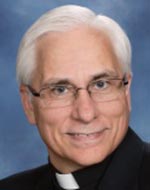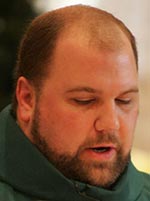This is the first in a series of articles introducing the 17 members of the Archdiocesan Synod Implementation Commission (ASIC) who meet quarterly. In addition to this group, all of whom were appointed by Archbishop Jerome E. Listecki, the commission includes four ex-officio members: the archbishop; Randy Nohl, archdiocesan director of synod implementation; Barbara Anne Cusack, archdiocesan chancellor; and Rich Harter, director of the John Paul II Center for the New Evangelization.
 Fr. Jeff HainesDuring last June’s Archdiocesan Synod, the top priority for evangelization read: “Implement a ‘Strategic Leadership Training Process’ to train archdiocesan staff, seminarians, priests, deacons, school principals, parish staffs and parish leaders in the vision, process, methods and skills of ‘Missionary Leadership for the New Evangelization.’”
Fr. Jeff HainesDuring last June’s Archdiocesan Synod, the top priority for evangelization read: “Implement a ‘Strategic Leadership Training Process’ to train archdiocesan staff, seminarians, priests, deacons, school principals, parish staffs and parish leaders in the vision, process, methods and skills of ‘Missionary Leadership for the New Evangelization.’”
In his synodal declaration calling for implementation of the synod’s priorities, Archbishop Jerome E. Listecki stated the archdiocese would “equip leaders throughout the archdiocese to exercise inspiring and effective missionary leadership for the new evangelization.”
That emphasis on missionary leadership speaks loudly for Fr. Jeff Haines, rector of the Cathedral of St. John the Evangelist.
 Jesuit Fr. Thomas Lawler
Jesuit Fr. Thomas Lawler
“One of the things the vision (of the synod implementation process) needs to incorporate is missionary leadership,” he said. “I feel that deeply.”
Fr. Haines, moderator of the Archdiocesan Council of Priests, said the church used to be trained for maintenance when “numbers weren’t an issue.” But that has changed as the number of Catholics has declined, and Mass attendance has decreased.
“We have to get back to being missionaries,” he said.
Given ASIC’s first-year implementation emphasis on evangelization and the Mass, Fr. Haines hopes people will experience a better understanding of the Mass and “then experience the treasure that the Eucharist is.”
“We presume people know what is going on; we take that for granted,” he said, noting that after parts of the Mass are explained, people will comment, ‘I never knew this stuff.’”
 Fr. Philip Bogacki
Fr. Philip Bogacki
Fr. Haines said the focus on the Mass will require parish leaders to “be much more intentional” in their teaching about the Mass.
“This will improve the depth of understanding and the vitality of the Mass where the Body of Christ is engaged and participating,” he said.
Fr. Haines said the Holy Spirit spoke to synod participants.
“Now, we must refocus our resources on what we’re going to teach; focus on what is important,” he said.
Jesuit Fr. Thomas Lawler, provincial of the Wisconsin Province of the Society of Jesus, brings, in his words, “an outside perspective – the perspective of a (religious) congregation that serves” to the synod implementation process.
“We’re a missionary order that is sent to where there is a need,” he said, noting the Jesuits’ – its charism – is working in education and with the poor.
Fr. Lawler said that the first place people encounter Christ is in the local church community.
“Our mission has to begin on the local level; it has to begin where people are,” he said of the process for implementing synod priorities.
Fr. Philip Bogacki, part of the team that assisted in the preparation of the pastoral letter, “Who Do You Say I Am?” in which Archbishop Listecki called for the Archdiocesan Synod, said having the Mass as the first synod priority to be implemented is “most important.”
“Eucharist brings everything else – social justice, work, formation, prayer – together,” he said.
Fr. Bogacki, pastor of Christ King Parish, Wauwatosa, noted the link between evangelization and Mass.
“We want people to understand the great treasure we have in the Eucharist,” he said. “There are people on the periphery looking for community, reconciliation, eternal life. People are searching for the Eucharist.”
Fr. Bogacki, noting that as a pastor he is “regularly engaged with a lot of people,” said that he is excited about bringing the archbishop’s vision to his parish – and beyond.
“The synod initiatives are going to touch them, evangelize them and engage them,” he said.
